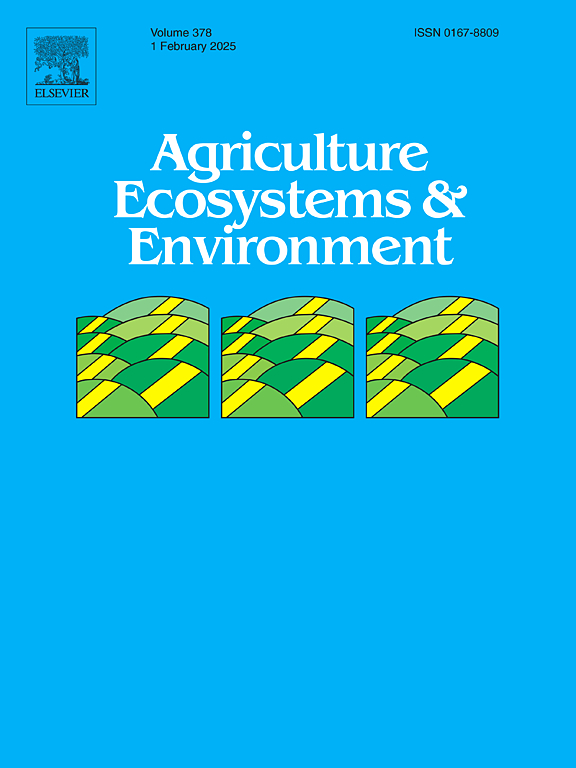Age-driven structural characteristics relate to epigeal arthropod communities in olive agroecosystems of the Atacama Desert
IF 6.4
1区 农林科学
Q1 AGRICULTURE, MULTIDISCIPLINARY
引用次数: 0
Abstract
Intensive agriculture has led to a significant global decline of biodiversity. However, agroecosystems like olive groves can serve as biodiversity refuges, especially in arid environments, by acting as resource islands that promote the persistence of multiple species, including arthropods. The structural complexity and productivity of olive groves typically increase with age, enhancing their ability to sustain high biodiversity. In this study, we examined how epigeal arthropod diversity patterns vary across olive orchards of different ages in the Huasco Valley of Chile's Atacama Desert. We hypothesized that older olive orchards, with greater structural complexity and productivity, would harbor higher arthropod abundance, diversity, and distinct community compositions than a younger olive orchard. To test this hypothesis, we sampled epigeal arthropods in three olive orchards of different ages (young, intermediate, and centennial) using pitfall traps and characterized each orchard's structure and productivity (NDVI). Our findings indicate that olive orchard age is related to arthropod composition and abundance but not diversity. Young and intermediate olive orchards had higher arthropod abundance, dominated by isopods and hymenopterans, while entomophthorans and mites predominated in the centennial orchard. Each orchard harbored a unique arthropod community, with NDVI being a key factor in the centennial orchard, dry weed biomass in intermediate orchards, and leaf litter in young groves. These results suggest that the structural characteristics associated with olive orchard age play a crucial role in shaping arthropod communities in arid environments, highlighting the importance of habitat management within agroecosystems for promoting biodiversity.
阿塔卡马沙漠橄榄农业生态系统中表皮节肢动物群落的年龄驱动结构特征
集约化农业导致了全球生物多样性的显著下降。然而,像橄榄林这样的农业生态系统可以作为生物多样性的避难所,特别是在干旱环境中,作为促进包括节肢动物在内的多种物种持续存在的资源岛。橄榄园的结构复杂性和生产力通常会随着年龄的增长而增加,从而增强其维持高生物多样性的能力。在这项研究中,我们研究了智利阿塔卡马沙漠Huasco山谷不同年龄橄榄果园的上肢节肢动物多样性模式。我们假设,与年轻的橄榄园相比,结构复杂性和生产力更高的老橄榄园可能拥有更高的节肢动物丰度、多样性和独特的群落组成。为了验证这一假设,我们在3个不同年龄(年轻、中期和百年)的橄榄果园中使用陷阱取样,并对每个果园的结构和生产力(NDVI)进行了表征。研究结果表明,橄榄园年龄与节肢动物组成和丰度有关,而与多样性无关。幼、中期橄榄园节肢动物丰度较高,以等足类和膜翅目昆虫为主,百年果园节肢动物和螨类为主。每个果园都有独特的节肢动物群落,其中NDVI是百年果园、中期果园干杂草生物量和幼林凋落叶的关键因子。这些结果表明,干旱环境下,与橄榄园年龄相关的结构特征在节肢动物群落的形成中起着至关重要的作用,突出了农业生态系统中栖息地管理对促进生物多样性的重要性。
本文章由计算机程序翻译,如有差异,请以英文原文为准。
求助全文
约1分钟内获得全文
求助全文
来源期刊

Agriculture, Ecosystems & Environment
环境科学-环境科学
CiteScore
11.70
自引率
9.10%
发文量
392
审稿时长
26 days
期刊介绍:
Agriculture, Ecosystems and Environment publishes scientific articles dealing with the interface between agroecosystems and the natural environment, specifically how agriculture influences the environment and how changes in that environment impact agroecosystems. Preference is given to papers from experimental and observational research at the field, system or landscape level, from studies that enhance our understanding of processes using data-based biophysical modelling, and papers that bridge scientific disciplines and integrate knowledge. All papers should be placed in an international or wide comparative context.
 求助内容:
求助内容: 应助结果提醒方式:
应助结果提醒方式:


